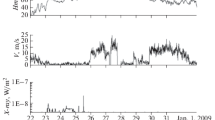Abstract
Synoptic and mesoscale cyclonic systems over the ocean and seas are often accompanied by thunderstorm activity, the intensity and spatial distribution of which is modulated by the dynamic structure of these systems. Lightning discharges are sources of electromagnetic radiation in the range of very low frequencies (VLF) and are detected by VLF location finders. Using the World Wide Lightning Location Network (WWLLN), relations between characteristics of fields of detected lightning discharges in the north-western part of the Pacific Ocean and those of fields of meteorological elements of weather formations estimated by data of remote sensing of the Earth by satellites are studied by an example of tropical cyclones. We illustrate a technique permitting one to connect thunderstorm activity parameters (frequency and intensity, as well as spatial distribution of lightning discharges) with the structure of weather systems over oceans and seas and with the intensity and forms of mesoscale formations distinguished in these systems by fields of the near-water wind vortex (the fields are obtained using a scatterometer) and by satellite images in the visible and infrared ranges. The relations between the frequency and density of lightning discharges in the range of influence of a tropical cyclone (TC) and spatial distribution of the near-water wind vortex are demonstrated by an example of individual TCs of 2005–2013.
Similar content being viewed by others
References
S. F. Abarca, K. L. Corbosiero, and D. Vollaro, “The world wide lightning location network and convective activity in tropical cyclones,” Mon. Weather. Rev. 139 (1), 175–191 (2011).
L. A. Leary and E. A. Ritchie, “Lightning flash rates as an indicator of tropical cyclone genesis in the Eastern North Pacific,” Mon. Weather. Rev. 137 (10), 3456–3470 (2009).
K. Squires and S. Businger, “The morphology of eyewall lightning outbreaks in two category 5 hurricanes,” Mon. Weather. Rev. 136 (5), 1706–1726 (2008).
K. S. Virts, J. M. Wallace, M. L. Hutchins, and R. H. Holzworth, “Highlights of a new ground-based, hourly global lightning climatology,” Bull. Amer. Meteorol. Soc. 94 (9), 1381–1391 (2013).
World Wide Lightning Location Network. http://wwlln.net.
E. Yu. Potalova, M. S. Permyakov, and T. I. Kleshcheva, “Mesoscale structure of tropical cyclones in the surface wind field,” Rus. Meteorol. Hydrol. 38 (11), 735–740 (2013).
Japan Meteorological Agency. http://www.jma.go.jp.
Joint Typhoon Warning Center. http://www.usno.navy.mil/JTWC/.
Remote Sensing Systems. http://www.remss.com.
W. M. Gray, “Hurricane: Their formation, structure and likely role in the tropical circulation,” Roy. Met. Soc. 105, 915–927 (1979).
Digital Typhoon: Images and Information. http://agora.ex.nii.ac.jp.
Author information
Authors and Affiliations
Corresponding author
Additional information
Original Russian Text © M.S. Permyakov, E.Yu. Potalova, B.M. Shevtsov, N.V. Cherneva, R.H. Holzworth, 2015, published in Optika Atmosfery i Okeana.
Rights and permissions
About this article
Cite this article
Permyakov, M.S., Potalova, E.Y., Shevtsov, B.M. et al. Thunderstorm activity and the structure of tropical cyclones. Atmos Ocean Opt 28, 585–590 (2015). https://doi.org/10.1134/S1024856015060123
Received:
Published:
Issue Date:
DOI: https://doi.org/10.1134/S1024856015060123




